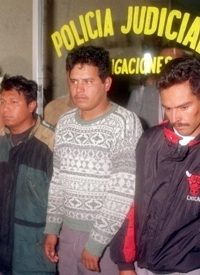
When the police department from the municipality of Ahome in the Mexican state of Sinaloa were summoned to meet with the director of state police, they thought they were going to discuss routine operations. Instead, they were disarmed and the 32 officers and commanders who make up the entire department were arrested for their connection with Los Zetas and the Beltran Leyva cartels.
According to a story at BorderlandBeat.com, the recent arrests came about because of information gained from a Beltran Leyva leader arrested in May:
After his arrest in May of this year Geovanny Lizárraga Ontiveros, a northern Sinaloa Beltran Leyva leader, confessed that he and Isidro Meza “el Chapo Isidro” had the Ahome police force on their payroll.In a news conference to announce the arrests, Gov. Mario Lopez Valdez explained that “In Ahome there are signs that the police are committing crimes, so the 32 officers and commanders were arrested with the assistance of federal authorities.”
This municipality and the municipalities of Culiacan, Mazatlan and Navolato are where most of the more than 1,800 homicides in the state in 2011, including more than 80 police officers, are concentrated.
It should also be mentioned that the Sinaloa cartel is widely believed to have deeply infiltrated the command structure of the state police forces in Sinaloa. (Italics in original.)
Police corruption is nothing new, but the extent of alleged criminality within the police department in Ahome is remarkable. However, the comments of Gov. Mario Lopez Valdez in the aftermath
of the arrests do little to allay concerns regarding the extent of police corruption within Sinaloa — and throughout Mexico. A November 15 article for Fox News Latino conveys both the governor’s commitment to root out corruption — and the hint that further mass arrests of police officers may be seen in the near future:
“Regrettably, after we had set a goal of reducing crime in the municipality of Ahome … there are signs of criminality by the police themselves,” López Valdez said, vowing not to relent in the battle against criminals, especially “those who wear a uniform.”
Though individual officers have been fired on suspicion of colluding with drug dealers, Monday’s sweep against the Ahome police department was the first large-scale operation against corrupt cops in Sinaloa.
The state government stands ready to carry out further police purges if needed, the governor said.
As reported a year ago for The New American, less than two percent of the crimes committed in Mexico are every punished by that nation’s justice system. When entire police departments are allegedly so corrupt that every single officer is arrested for being on the payroll of one of the drug cartels, it is little wonder that so few crimes are ever punished in the Mexican courts. Given such an absurdly low rate of effective prosecutions for criminal acts, it is not surprising that crime — and violent crime, in particular — is simply out of control in many areas of Mexico.
The ongoing conflict between the Mexican government and the numerous drug cartels has led to a steady, northward advance of the crime and violence from south of the U.S.-Mexico border into Texas and the American Southwest. Just last month, Reuters reported that Los Zetas and other cartels are recruiting American children as young as 11 years of age to carry out crimes, including transportation of large quantities of drugs.
As Melissa Correa reported for KRGV (the local ABC-affiliated television station for the Rio Grande Valley), the influence of the cartels has become so pervasive that Dallas is major hub for the drug trade:
Federal agents say Dallas is a hub for the Mexican drug cartels.
“We’ve listened, through wire taps, and we know the organizations’ commanding control cell are talking to commanding control cells in Mexico — directly to the trafficking cartel heads,” says Drug Enforcement Agency Agent James Capra.
Capra says the Gulf Cartel, La Familia, and the Sinaloa Cartel all have a presence in Dallas.
“They have familial roots here. Some of them grew up here, have families here, have established networks here,” he says.
Such “familial roots” are easy to establish when the federal government has largely abandoned its responsibility to control the nation’s borders and simply allows millions of illegal aliens to flood into the United States from Mexico. When the inherent criminality of illegal immigration is virtually ignored by politicians, it hardly seems all that astounding that the influx of such aliens would bring other forms of crime with them. Agent Capra told Correa that a wide variety of individuals are now involved in the crimes of the cartels: “We’ve had illegals. We’ve had American citizens. You name it, we’ve had it across the gamut.” But the network of criminal activity could not have been so easily established if the borders had been secured.
When law enforcement officials in Arizona recently announced the arrest of 76 suspects accused of crimes connected with the activities of the Sinaloa cartel, half of those arrested were illegal aliens.
An entire Mexican police department arrested on charges of collusion with the drug cartels bespeaks the extent of the lawlessness now present south of the border. The mass arrests of cartel members in American cities makes it clear that the criminality which has run rampant south of the border is now steadily spreading within the territory of the United States. In considering the activities of Mexico’s most violent gates, issues of immigration and crime are inextricably linked, and neither problem can endure further neglect without posing an ever-greater danger to the Republic.
Photo: A gang of Mexican police officers was charged in the killings of 17 people in Toluca, Mexico, in 1999: AP Images



